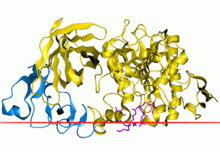User:Mr. Ibrahem/Pancreatic enzymes (medication)
 Complex of lipase with colipase | |
| Clinical data | |
|---|---|
| Trade names | Creon, Pancreaze, Pancrex, others |
| AHFS/Drugs.com | Monograph |
| MedlinePlus | a604035 |
| Pregnancy category |
|
| Routes of administration | By mouth |
Pancreatic enzymes, also known as pancrelipase and pancreatin, are commercial mixtures of amylase, lipase, and protease.[1][3] They are used to treat malabsorption syndrome due to certain pancreatic problems.[1] These pancreatic problems may be due to cystic fibrosis, surgical removal of the pancreas, long term pancreatitis, or pancreatic cancer, among others.[1][4] The preparation is taken by mouth.[1]
Common side effects include vomiting, abdominal pain, constipation, and diarrhea.[1] Other side effects include perianal irritation and high blood uric acid.[4] The enzymes are from pigs.[4] Use is believed to be safe during pregnancy.[4] The components are digestive enzymes similar to those normally produced by the human pancreas.[5] They help the person digest fats, starches, and proteins.[4]
Pancreatic enzymes have been used as medications since at least the 1800s.[6] They are on the World Health Organization's List of Essential Medicines.[7] In the United Kingdom a typical month's supply costs the NHS about £12.93 to £47.55 as of 2019.[8] In the United States the wholesale cost of this amount is about US$300 to US$900.[9] In 2017, it was the 275th most commonly prescribed medication in the United States, with more than one million prescriptions.[10][11]
References[edit]
- ^ a b c d e f g "Pancrelipase". The American Society of Health-System Pharmacists. Archived from the original on 18 January 2017. Retrieved 8 January 2017.
- ^ "WHOCC - ATC/DDD Index". www.whocc.no. Archived from the original on 1 July 2021. Retrieved 12 September 2020.
- ^ "Pancreatin". The American Society of Health-System Pharmacists. Archived from the original on 18 January 2017. Retrieved 8 January 2017.
- ^ a b c d e British national formulary: BNF 69 (69 ed.). British Medical Association. 2015. pp. 82–83. ISBN 9780857111562.
- ^ Stuhan, Mary Ann (2013). Understanding Pharmacology for Pharmacy Technicians. ASHP. p. 597. ISBN 9781585283606. Archived from the original on 2017-09-14.
- ^ Bagchi, Debasis; Swaroop, Anand; Bagchi, Manashi (2015). Genomics, Proteomics and Metabolomics in Nutraceuticals and Functional Foods. John Wiley & Sons. p. 274. ISBN 9781118930465. Archived from the original on 2017-09-18.
- ^ World Health Organization (2019). World Health Organization model list of essential medicines: 21st list 2019. Geneva: World Health Organization. hdl:10665/325771. WHO/MVP/EMP/IAU/2019.06. License: CC BY-NC-SA 3.0 IGO.
- ^ British national formulary: BNF 76 (76 ed.). Pharmaceutical Press. 2018. pp. 96–97. ISBN 9780857113382.
- ^ "NADAC as of 2019-02-27". Centers for Medicare and Medicaid Services. Archived from the original on 2019-03-06. Retrieved 3 March 2019.
- ^ "The Top 300 of 2020". ClinCalc. Archived from the original on 12 February 2021. Retrieved 11 April 2020.
- ^ "Pancrelipase Lipase; Pancrelipase Protease; Pancrelipase Amylase - Drug Usage Statistics". ClinCalc. Archived from the original on 8 July 2020. Retrieved 11 April 2020.
